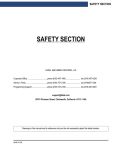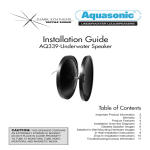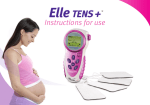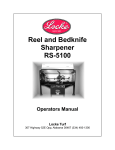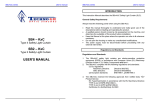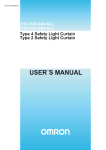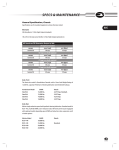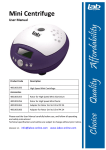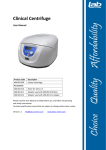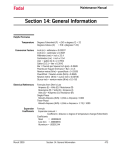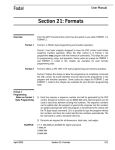Download Safety Section - 1.5MB - Flint Machine Tools, Inc.
Transcript
FADAL MACHINING CENTERS SAFETY SECTION FADAL MACHINING CENTERS, LLC Corporate Office....................................... phone (818) 407-1400 .............................fax (818) 407-0020 Service / Parts ......................................... phone (818) 727-2100 .............................fax (818) 407-1004 Programming Support.............................. phone (818) 727-2100 .............................fax (818) 407-0061 [email protected] 20701 Plummer Street, Chatsworth, California 91311 USA Drawings in this manual are for reference only and do not necessarily depict the latest revision. i MAN-0113R1 SAFETY SECTION TABLE OF CONTENTS 1.0 SAFETY WARNINGS . . . . . . . . . . . . . . . . . . . . . . . . . . . . . . . . . . . . . . . . . . . . . 1 2.0 GENERAL . . . . . . . . . . . . . . . . . . . . . . . . . . . . . . . . . . . . . . . . . . . . . . . . . . . . . 2 2.1 WARNINGS AND CAUTIONS . . . . . . . . . . . . . . . . . . . . . . . . . . . . . . . . . . . . . . . . . . . . . . .4 2.2 PICTORIALS . . . . . . . . . . . . . . . . . . . . . . . . . . . . . . . . . . . . . . . . . . . . . . . . . . . . . . . . . .4 2.3 POTENTIAL HAZARDS TO PERSONNEL . . . . . . . . . . . . . . . . . . . . . . . . . . . . . . . . . . . . . .4 2.3.1 ROTATING CUTTING TOOLS . . . . . . . . . . . . . . . . . . . . . . . . . . . . . . . . . . . . . . . . . . . . . . . 4 2.3.2 ELECTRIC SHOCK . . . . . . . . . . . . . . . . . . . . . . . . . . . . . . . . . . . . . . . . . . . . . . . . . . . . . . .5 2.3.3 SHARP EDGES ON CUTTING TOOLS . . . . . . . . . . . . . . . . . . . . . . . . . . . . . . . . . . . . . . . . . .5 2.3.4 NOISE (CE COMPLIANCE) . . . . . . . . . . . . . . . . . . . . . . . . . . . . . . . . . . . . . . . . . . . . . . . . . . .5 2.3.5 COMPRESSED AIR (CE COMPLIANCE) . . . . . . . . . . . . . . . . . . . . . . . . . . . . . . . . . . . . . . . .6 2.4 PHYSICAL ENVIROMENTAL AND OPERATING CONDITIONS . . . . . . . . . . . . . . . . . . . . . . . 6 3.0 US SAFETY LABELS . . . . . . . . . . . . . . . . . . . . . . . . . . . . . . . . . . . . . . . . . . . . 8 3.1 DANGER . . . . . . . . . . . . . . . . . . . . . . . . . . . . . . . . . . . . . . . . . . . . . . . . . . . . . . . . . . . . .8 3.1.1 SAFETY INSTRUCTIONS . . . . . . . . . . . . . . . . . . . . . . . . . . . . . . . . . . . . . . . . . . . . . . . . . . . 8 3.1.2 ROTATING CUTTING TOOLS . . . . . . . . . . . . . . . . . . . . . . . . . . . . . . . . . . . . . . . . . . . . . . . .10 3.1.3 MOVING PARTS . . . . . . . . . . . . . . . . . . . . . . . . . . . . . . . . . . . . . . . . . . . . . . . . . . . . . . . . 11 3.1.4 HAZARDOUS VOLTAGES . . . . . . . . . . . . . . . . . . . . . . . . . . . . . . . . . . . . . . . . . . . . . . . . .11 3.1.5 ROTATING CUTTING TOOLS . . . . . . . . . . . . . . . . . . . . . . . . . . . . . . . . . . . . . . . . . . . . . . 12 3.1.6 SPINDLE HEAD IS NOT COUNTERBALANCED . . . . . . . . . . . . . . . . . . . . . . . . . . . . . . . . . . 12 3.1.7 VERTICAL AXIS . . . . . . . . . . . . . . . . . . . . . . . . . . . . . . . . . . . . . . . . . . . . . . . . . . . . . . . . .13 3.1.8 AUGER AND CONVEYOUR . . . . . . . . . . . . . . . . . . . . . . . . . . . . . . . . . . . . . . . . . . . . . . . . 14 3.1.9 PALLET DOOR . . . . . . . . . . . . . . . . . . . . . . . . . . . . . . . . . . . . . . . . . . . . . . . . . . . . . . . . . .14 3.2 WARNING . . . . . . . . . . . . . . . . . . . . . . . . . . . . . . . . . . . . . . . . . . . . . . . . . . . . . . . . . . . 15 3.2.1 SHARP EDGES ON CUTTING TOOLS . . . . . . . . . . . . . . . . . . . . . . . . . . . . . . . . . . . . . . . . . 15 3.2.2 HAZARDOUS VOLTAGES . . . . . . . . . . . . . . . . . . . . . . . . . . . . . . . . . . . . . . . . . . . . . . . . . . 15 3.2.3 READ OPERATOR’S MANUAL . . . . . . . . . . . . . . . . . . . . . . . . . . . . . . . . . . . . . . . . . . . . . . 16 3.2.4 EYE AND EAR PROTECTION . . . . . . . . . . . . . . . . . . . . . . . . . . . . . . . . . . . . . . . . . . . . . . . 16 3.2.5 VERTICAL AXIS . . . . . . . . . . . . . . . . . . . . . . . . . . . . . . . . . . . . . . . . . . . . . . . . . . . . . . . . 17 3.2.6 COMPRESSED AIR . . . . . . . . . . . . . . . . . . . . . . . . . . . . . . . . . . . . . . . . . . . . . . . . . . . . . 18 3.3 CAUTION . . . . . . . . . . . . . . . . . . . . . . . . . . . . . . . . . . . . . . . . . . . . . . . . . . . . . . . . . .19 3.3.1 WEIGHT . . . . . . . . . . . . . . . . . . . . . . . . . . . . . . . . . . . . . . . . . . . . . . . . . . . . . . . . . . . .19 3.4 OTHER WARNINGS . . . . . . . . . . . . . . . . . . . . . . . . . . . . . . . . . . . . . . . . . . . . . . . . . . . 20 3.4.1 HAZARDOUS VOLTAGES . . . . . . . . . . . . . . . . . . . . . . . . . . . . . . . . . . . . . . . . . . . . . . . . 20 3.4.2 SERVICE BY AUTHORIZED PERSONNEL ONLY . . . . . . . . . . . . . . . . . . . . . . . . . . . . . . . . . .20 3.4.3 MAINTENANCE LABELS . . . . . . . . . . . . . . . . . . . . . . . . . . . . . . . . . . . . . . . . . . . . . . . . . . 21 3.4.4 GROUNDING REQUIREMENTS . . . . . . . . . . . . . . . . . . . . . . . . . . . . . . . . . . . . . . . . . . . . . 22 MARCH 2005 TABLE OF CONTENTS ii FADAL MACHINING CENTERS 4.0 CE SAFETY LABELS . . . . . . . . . . . . . . . . . . . . . . . . . . . . . . . . . . . . . . . . . . . . 23 4.1 TRIANGLES . . . . . . . . . . . . . . . . . . . . . . . . . . . . . . . . . . . . . . . . . . . . . . . . . . . . . . . . 23 4.1.1 ROTATING CUTTING TOOLS . . . . . . . . . . . . . . . . . . . . . . . . . . . . . . . . . . . . . . . . . . . . . . . 23 4.1.2 BELT OR CHAIN DRIVE . . . . . . . . . . . . . . . . . . . . . . . . . . . . . . . . . . . . . . . . . . . . . . . . . . . 23 4.1.3 HAZARDOUS VOLTAGES . . . . . . . . . . . . . . . . . . . . . . . . . . . . . . . . . . . . . . . . . . . . . . . . . 24 4.1.4 EYE AND EAR PROTECTION . . . . . . . . . . . . . . . . . . . . . . . . . . . . . . . . . . . . . . . . . . . . . . . 24 4.1.5 EYE PROTECTION . . . . . . . . . . . . . . . . . . . . . . . . . . . . . . . . . . . . . . . . . . . . . . . . . . . . . . 25 4.1.6 COMPRESSED AIR . . . . . . . . . . . . . . . . . . . . . . . . . . . . . . . . . . . . . . . . . . . . . . . . . . . . . .25 4.1.7 AUGER AND CONVEYOUR . . . . . . . . . . . . . . . . . . . . . . . . . . . . . . . . . . . . . . . . . . . . . . . . 26 4.1.8 MOVING PARTS . . . . . . . . . . . . . . . . . . . . . . . . . . . . . . . . . . . . . . . . . . . . . . . . . . . . . . . .26 4.1.9 FORCE FROM SIDE . . . . . . . . . . . . . . . . . . . . . . . . . . . . . . . . . . . . . . . . . . . . . . . . . . . . . 27 4.1.10 DRAWING IN . . . . . . . . . . . . . . . . . . . . . . . . . . . . . . . . . . . . . . . . . . . . . . . . . . . . . . . . .27 4.1.11 IMPACT FROM ABOVE . . . . . . . . . . . . . . . . . . . . . . . . . . . . . . . . . . . . . . . . . . . . . . . . . . 28 4.1.12 CRUSH FROM ABOVE . . . . . . . . . . . . . . . . . . . . . . . . . . . . . . . . . . . . . . . . . . . . . . . . . . 28 4.2 CIRCLES . . . . . . . . . . . . . . . . . . . . . . . . . . . . . . . . . . . . . . . . . . . . . . . . . . . . . . . . . . 29 4.2.1 NO OPEN OR REMOVED GUARDS . . . . . . . . . . . . . . . . . . . . . . . . . . . . . . . . . . . . . . . . . . . 29 4.2.2 WEAR EYE PROTECTION . . . . . . . . . . . . . . . . . . . . . . . . . . . . . . . . . . . . . . . . . . . . . . . . . .29 4.2.3 WEAR EAR PROTECTION . . . . . . . . . . . . . . . . . . . . . . . . . . . . . . . . . . . . . . . . . . . . . . . . . 30 4.2.4 READ OPERATOR’S MANUAL . . . . . . . . . . . . . . . . . . . . . . . . . . . . . . . . . . . . . . . . . . . . . . 30 4.2.5 LOCKOUT ELECTRICAL POWER . . . . . . . . . . . . . . . . . . . . . . . . . . . . . . . . . . . . . . . . . . . . 31 4.3 INFORMATION . . . . . . . . . . . . . . . . . . . . . . . . . . . . . . . . . . . . . . . . . . . . . . . . . . . . . . 31 4.3.1 MAXIMUM TOOL DIAMETER . . . . . . . . . . . . . . . . . . . . . . . . . . . . . . . . . . . . . . . . . . . . . . .31 4.3.2 MAXIMUM RPM . . . . . . . . . . . . . . . . . . . . . . . . . . . . . . . . . . . . . . . . . . . . . . . . . . . . . . . . 32 4.4 COMBINED SHAPES . . . . . . . . . . . . . . . . . . . . . . . . . . . . . . . . . . . . . . . . . . . . . . . . . . . 33 5.0 INDEX . . . . . . . . . . . . . . . . . . . . . . . . . . . . . . . . . . . . . . . . . . . . . . . . . . . . . . . 34 5.1 ALPHABETICAL ORDER OF LABELS . . . . . . . . . . . . . . . . . . . . . . . . . . . . . . . . . . . . . . . 34 5.2 NUMERICAL ORDER OF PART NO . . . . . . . . . . . . . . . . . . . . . . . . . . . . . . . . . . . . . . . . .36 iii TABLE OF CONTENTS MAN-0113R1 FADAL MACHINING CENTERS 1.0 SAFETY WARNINGS 1. KEEP DOORS CLOSED WHILE MACHINING. 2. DO NOT DISCONNECT THE FRONT DOOR SAFETY SWITCHES. 3. The front door is equipped with an interlock to prevent automatic of the VMC from when the door is open. Under no circumstances should the operator disable or remove the interlocks. If power is lost to the VMC, the spindle may coast for 30 seconds or more. Under no circumstances should the operator open the door before the spindle stops rotating completely. 4. READ AND UNDERSTAND THE OPERATOR’s MANUAL before using the VMC. 5. WARNING! WEAR ANSI or CE APPROVED SAFETY GLASSES AT ALL TIMES when operating machine. Everyday glasses are not designed for protection. Only ANSI or CE approved safety glasses have impact resistant lenses. 6. WEAR PROPER APPAREL. Do not wear loose clothing, gloves, neckties, rings, bracelets, or other jewelry that might get caught in moving parts or areas of potential electric shock. Non-slip footwear is recommended. 7. CONTAIN LONG HAIR. Tie long hair back and wear protective hair covering to contain long hair. 8. DO NOT EXCEED THE MANUFACTURER’s RECOMMENDED MAXIMUM RPM FOR THE TOOL. When tools are placed in the spindle, verify the current RPM commanded in the control before starting the spindle. 9. HEARING PROTECTION must be worn when operations exceed 90 (85 CE) decibels. 10. USE A NIOSH OR CE APPROVED DUST MASK OR RESPIRATOR. Protection is recommended when cutting operations are dusty or exceed the permissible exposure limit. 11. DO NOT OPERATE THE MACHINE UNDER THE INFLUENCE OF DRUGS OR ALCOHOL, PRESCRIBED OR OTHERWISE. 12. READ THE SAFETY WARNINGS SUPPLIED WITH ALL TOOLING. 13. KEEP WORK AREA CLEAN. Good housekeeping practices encourage safety. 14. Read SPINDLE, MANUALLY LOADING & UNLOADING A HOLDER in the Operator’s Manual. 1 of 37 1.0 SAFETY WARNINGS MAN-0113R1 SAFETY SECTION 15. REMOVE ADJUSTING KEYS AND WRENCHES. Always check that keys and wrenches are removed from tools and tooling before starting the machine. 16. MAINTAIN TOOLS WITH CARE. Keep tools sharp and clean for best performance and to reduce the risk of injury. Follow instructions for lubrication and for changing accessories. 17. SECURE TOOLS PROPERLY IN THEIR HOLDERS. 18. SECURE WORK. Use standard machining practices for holding (fixturing) material to be machined. 19. MAINTAIN THE TOOLS WITH CARE. Keep tools sharp and clean for best performance and reduction of the risk of injury. Follow instructions for lubrication and for changing accessories. 20. DO NOT FORCE TOOL. Tools are designed to perform properly and safely at proper rates. Keep tools sharp. 21. USE THE CORRECT TOOL. Do not attempt to use tools or attachments to perform a job for which they were not designed. 22. DO NOT OVERREACH. Keep proper footing and balance at all times. Use a steady object for support when reaching over the machine. 23. ALWAYS DEBUG A NEW PROGRAM before running it in the AUTO mode. (See DEBUG PROGRAM in the User’s Manual.) 24. DO NOT OPERATE THE MACHINE IN AN UNSAFE ENVIRONMENT. Do not use the machine in damp or wet locations, or expose to rain. Keep the work area well lighted. Do not turn the VMC on or try to operate it if there are explosive or flammable gases present. 25. The machine is not intended for use with flammable or harmful substances. 26. Take appropriate additional safety precautions and measures when working with magnesium, wood, or other combustible materials. 27. Dust removal equipment is needed when working with dust-producing materials or procedures. 28. REDUCE THE RISK OF UNINTENTIONAL STARTING. Power off the machine at the main disconnect switch and use the proper lockout/tagout procedures while working within the chip enclosure. 29. NEVER WORK ON LIVE ELECTRICAL CIRCUITS. Power off the machine at the main disconnect switch and lock out when working inside any of the electronic cabinets. 30. USE RECOMMENDED ACCESSORIES. Refer to the User’s Manual for FADAL recommended accessories. Unapproved accessories increase the risk of injury. MARCH 2005 1.0 SAFETY WARNINGS 2 of 37 FADAL MACHINING CENTERS 31. NEVER STAND ON OR IN THE MACHINE. Besides the risk of slipping or falling, serious injury can occur if a tool is unintentionally contacted. 32. CHECK FOR DAMAGED PARTS. Always check all parts for binding, breakage, and any other condition that will affect the proper operation of the machine and/or increase the risk of injury. Damaged or missing parts must be repaired or replaced BEFORE operating the machine. 33. NEVER LEAVE THE MACHINE UNATTENDED. Turn off the power to the machine when leaving the machine unattended. Never leave the machine until it comes to a complete stop. 34. WIPE UP SPILLS. Immediately cover with absorbent material and wipe up coolant and oil spills around the machine. Correct the cause of the leakage to prevent any hazards. 35. ELECTRICAL INSTALLATION OF THE MACHINE MUST BE DONE BY A QUALIFIED ELECTRICIAN. 36. The machine tool MUST BE connected to a grounded, metal, permanent wiring system, or to a system having an equipment-grounding conductor. 37. ONLY FADAL OR FADAL DISTRIBUTOR FACTORY AUTHORIZED INDIVIDUALS MAY INSTALL THE MACHINE. 38. Do not enter enclosure area for service or maintenance unless machine is off and power is locked out. Due to danger of slips or falls on a wet or oily surface, table and enclosure floor should be clean and dry before using them for maintenance access. 39. Contact FADAL or your local distributor for all repair parts and service. 40. USE PROPER SAFETY GLOVES WHEN HANDLING SHARP OR JAGGED EDGES. Do not wear gloves around rotating machinery. 41. The Poly-carbonate viewing panels are an integral part of safety enclosure for the VMC. They must be inspected at least monthly for any signs of reduced effectiveness (such as cracking or crazing) and replaced immediately, if such signs or other indications of reduced effectiveness are noticed. Furthermore, tests have indicated that coolants can reduce the effectiveness of the panels over a period of time, therefore the panels should be replaced, regardless of condition, at least every two years. 3 of 37 1.0 SAFETY WARNINGS MAN-0113R1 SAFETY SECTION 2.0 GENERAL A carelessly or improperly operated VMC can cause serious injury or death as well as damage or destruction of equipment. The emergency and safety procedures in this manual are to help users operate the VMC in a safe manner. The warnings in this manual follow accepted industry safety practices. Tasks involving toxic materials must be reviewed and approved by an industrial hygienist or safety engineer. Fadal has no control over the applications the operator may use the VMC for and is not responsible for injuries or equipment damage. Read and understand the Operator’s Manual. The safe use and disposal of all hazardous materials processed or used by the VMC is the responsibility of the user. All safety warnings and procedures must be followed. It is the sole responsibility of the user to comply with all local, state, national (Federal), international and environmental safety laws and regulations applicable to the VMC and its use. 2.1 WARNINGS AND CAUTIONS This manual contains information that will assist qualified operators and maintenance personnel. Unqualified operators should never attempt to operate or perform maintenance on the VMC. 2.2 PICTORIALS Pictorials are used within warnings to rapidly communicate a hazard to the reader. The pictorials and their meaning are given in this section. 2.3 POTENTIAL HAZARDS TO PERSONNEL The most serious potential hazards associated with the VMC are: • rotating cutting tools • electric shock • sharp edges on cutting tools • noise • compressed air 2.3.1 ROTATING CUTTING TOOLS Rotating cutting tools used by the VMC create potential hazards of entanglement. A cutting hazard is also possible if the operator comes into contact with rotating cutting tools. The Poly-carbonate shield is equipped with an interlock to prevent the VMC from operating when the shield is opened. MARCH 2005 2.0 GENERAL 4 of 37 FADAL MACHINING CENTERS Under no circumstances should operators disable or remove the interlocks. If the interlock is not functioning properly, qualified maintenance personnel should be notified and the VMC must not be used until it is functioning properly. Prior to starting any job, the VMC operator should inspect all of the cutting tools being used to ensure they are in good condition and free from defects such as cracks. The operator should also insure that only the appropriate cutting tools for the material being machined are present. Using the wrong or a damaged tool can result in the failure of the tool or material being machined. Failure of either can lead to pieces of either the tool or the material being ejected at extremely high speed. Ejection of either can lead to serious injury or death to personnel in the vicinity. Major equipment damage could also be sustained. 2.3.2 ELECTRIC SHOCK The VMC has numerous subsystems powered by high voltage electricity. This electricity is not a hazard during most operations, however certain maintenance operations conducted by qualified individuals may require the defeat of interlocks so that power may be maintained during diagnostic or adjustment tasks. Under no circumstances should the operator defeat any interlocks. Read all applicable manuals and follow their warnings to prevent accidental electric shock. Operators must never remove shields or panels, nor should operators bypass or otherwise disable interlocks. 2.3.3 SHARP EDGES ON CUTTING TOOLS 2.3.4 NOISE Cutting tools have sharp edges that can lead to a serious cut. The tools used on the VMC are stored in a tool tray when not being used. Under most circumstances they pose no threat to operator or maintenance personnel. It is possible for personnel to come into contact with stationary cutting tools during job setup or when replacing cutting tools for any reason. Extreme care must be taken to avoid coming into contact with the sharp edges on cutting tools. Exposure to occupational hazardous noise or prolonged exposure to noise above 85 decibels may cause permanent hearing damage. The sound of noise the VMC produces varies by the type of material, speed of the cut, and several other factors. To prevent loss of hearing from the noise of an operating VMC, hearing protection must always be worn by personnel exposed to noise above 85 decibels or above. The level of protection required may vary because of variation in the amount of noise being produced by the VMC. To insure 5 of 37 2.0 GENERAL MAN-0113R1 SAFETY SECTION adequate hearing protection is attained, compliance with CE standards is required. Consult a qualified industrial hygienist or safety engineer to insure adequate protection prior to operating the VMC. Continuous equivalent A-weighted sound pressure at workstation is 77dB(A) or less when tested according to Annex D of prEN 12417. The figures quoted are emission levels and are not necessarily safe working levels. While there is a correlation between the emission and exposure levels, this cannot be used reliably to determine whether or not further precautions are required. Factors that influence the actual level of exposure of the workforce include characteristics of the work room, the other sources of noise, etc. i.e., the number of machines and other adjacent processes. Also the permissible exposure level can vary from country to country. This information, however, will enable the user of the machine to make a better evaluation of the hazard and risk. 2.3.5 COMPRESSED AIR Compressed air poses a potential hazard from flying debris. Under normal conditions the compressed air may not present a hazard to the operator. Failure of any component of a compressed air system may cause parts to be ejected at high speed. Operators and maintenance personnel must always wear eye protection that meets OSHA standards and ANSI standard Z87.1 (or CE standards) when working on systems that use compressed air. The operator may also use their shop’s compressed air to remove debris from material being machined. If shop air is used for this purpose, it must be done in accordance with OSHA or CE standards. Alternative means of debris removal, such as debris rakes, should be considered. UNDER NO CIRCUMSTANCES SHOULD THE OPERATOR ATTEMPT TO REMOVE DEBRIS WHILE THE VMC IS RUNNING. Consult a qualified industrial hygienist or safety engineer to insure debris removal is accomplished in a safe manner and in a manner that complies with local, state, national (Federal), and international regulations. 2.4 PHYSICAL ENVIROMENTAL AND OPERATING CONDITIONS CE SPECIFICATIONS. MARCH 2005 FADAL VMCs meet or exceed the environmental requirements stated in EN 60204-1:1992 section 4.4. Electromagnetic Compatibility meets or exceeds the levels specified by EN 50081-2:1993 and EN 50082-2:1995. Ambient air temperature conforms as specified in EN60204-1:1992 section 4.4.2 (+5 deg C to +40 deg C). Humidity conforms as specified in EN60204-1:1992 section 4.4.3 (relative humidity 30% to 95% non-condensing). Altitude conforms as specified in EN60204-1:1992 section 4.4.4 (maximum altitude without derating exceeds 1000 meters above sea level). 2.0 GENERAL 6 of 37 FADAL MACHINING CENTERS Contaminants conform as specified in EN60204-1:1992 section 4.4.5. Equipment is not intended for use in a corrosive atmosphere. Equipment that will be used in an environment with excessive amounts of fine conductive particulate matter (e.g. graphite) must be ordered with the graphite restraint package. 7 of 37 2.0 GENERAL MAN-0113R1 SAFETY SECTION 3.0 US SAFETY LABELS 3.1 DANGER “DANGER” - indicates an imminently hazardous situation which, if not avoided, will result in death or serious injury. 3.1.1 SAFETY INSTRUCTIONS Safety Instruction 1. MARCH 2005 3.0 US SAFETY LABELS 8 of 37 FADAL MACHINING CENTERS Safety Instruction 2. This label summarizes the hazardous situations that could result in serious injury or death when using the machine. Read the warnings carefully and follow the instructions to avoid serious injury or death. The safety instruction label 1. is used on all machines except for the TRM. The safety instruction label 2. is used only for the TRM. 9 of 37 3.0 US SAFETY LABELS MAN-0113R1 SAFETY SECTION 3.1.2 ROTATING CUTTING TOOLS - DO NOT OPERATE WITH OPEN DOORS Rotating Cutting Tools Rotating cutting tools can cause serious injuries or death. Never get close to rotating tool. Do not operate the machine unless the doors are closed. Make sure that the door interlocks are working. In addition to the hazard of cuts and entanglement, the cutter can throw chips, break and throw part of the cutter, or grab and throw the part. Any of these can result in a serious injury or death. MARCH 2005 3.0 US SAFETY LABELS 10 of 37 FADAL MACHINING CENTERS 3.1.3 MOVING PARTS KEEP YOUR HANDS AWAY FROM MOVING PARTS Moving Parts Pulleys, belts and gears can result in serious injury. The machine should not be operated with guards removed. Before service the machine should be powered off and power locked out. 3.1.4 HAZARDOUS VOlTAGES - LOCKOUT BEFORE SERVICING Hazardous Voltages The electrical cabinet contains voltages that can be lethal. The machine should only be serviced by qualified personnel and power should be off and locked out before service. 11 of 37 3.0 US SAFETY LABELS MAN-0113R1 SAFETY SECTION 3.1.5 ROTATING CUTTING TOOLS - DO NOT REMOVE OR MODIFY COMPONENTS Rotating Cutting Tools The components and controls in the electrical cabinets are specially designed or selected for their function. Any change of the components can result in a loss of safety. Do not change or modify any components. Service should be performed by factory trained personnel only. 3.1.6 SPINDLE HEAD IS NOT COUNTERBALANCED Not Counterbalanced Spindle Head Many of the machine models use a brake built into the vertical axis servo motor instead of a counterweight to hold the vertical axis against the power of gravity when the machine is off. When working under the spindle head or when working on the servo motor or coupler, make sure that the head is locked in MARCH 2005 3.0 US SAFETY LABELS 12 of 37 FADAL MACHINING CENTERS place. Some machines use a large pin to accomplish this. Most use set screws that are built into the side of the spindle head. 3.1.7 VERTICAL AXIS CRUSH HAZARD Vertical Axis When the vertical axis of the HMC moves, it includes the spindle motor which can be accessed from the back of the HMC. A guard restricts access to this area. When access to this area is required the HMC must not be moving. Never work under the spindle motor unless the machine is off and power is locked out. 13 of 37 3.0 US SAFETY LABELS MAN-0113R1 SAFETY SECTION 3.1.8 AUGER AND CONVEYOUR Auger Conveyor Chips removal systems are very dangerous. Never try to unblock chips with your hand. Never stand in or near the auger or conveyor. Turn off and lock out power before doing any service on the auger or chip conveyor. If auger is jamme beware of stored energy in the auger. When freed it may move suddenly. 3.1.9 PALLET DOOR HAND CRUSH Pallet Door When the pallet is in operation the operator and all others should keep away from the moving pallet and the automatic pallet door. Serious injury could result. MARCH 2005 3.0 US SAFETY LABELS 14 of 37 FADAL MACHINING CENTERS 3.2 WARNING “WARNING” - indicates a potentially hazardous situation which, if not avoided, could result in death or serious injury. 3.2.1 SHARP EDGES ON CUTTING TOOLS Cutting Tool Edges Cutting tools can be very dangerous even when not moving. Keep hands and other parts away from all sharp edges. Do not handle sharp tools without gloves. 3.2.2 HAZARDOUS VOLTAGES - DO NOT OPERATE WITH DOOR OPEN Hazardous Voltages Potentially lethal voltage are present in the electrical cabinets. Keep the doors closed. Only factory trained personnel should service the machine. 15 of 37 3.0 US SAFETY LABELS MAN-0113R1 SAFETY SECTION 3.2.3 READ OPERATOR’S MANUAL Reading Operator’s Manual The operator’s manual contains information that is vital to the safe operation of the machine. Read and understand the manual before operating the machine. Only trained and qualified personnel should be allowed to operate the machine. 3.2.4 EYE AND EAR PROTECTION Eye and Ear Protection 1. MARCH 2005 3.0 US SAFETY LABELS 16 of 37 FADAL MACHINING CENTERS Eye and Ear Protection 2 Flying chips and loud noise are unavoidable consequences of machining. Always wear eye and ear protection. The eye and ear protection 1 label is used on all machines except for the TRM. The eye and ear protection label 2 is used only for the TRM. 3.2.5 VERTICAL AXIS MOVEMENT Vertical Axis The vertical axis of the HMC poses an impact hazard from the back of the machine. It also poses a more serious crush hazard. Do not operate the machine with the guard to this area open. 17 of 37 3.0 US SAFETY LABELS MAN-0113R1 SAFETY SECTION Turn off the machine and lockout power before doing any service or maintenance in this area. 3.2.6 COMPRESSED AIR Compressed Air Some of the systems on the machine use compressed air. Hoses can break or come loose. Wear eye protection. Never perform maintenance on systems that are pressurized. Disconnect the air source to the machine before performing any maintenance. MARCH 2005 3.0 US SAFETY LABELS 18 of 37 FADAL MACHINING CENTERS 3.3 CAUTION “CAUTION” -indicates a potentially hazardous situation which may result in minor or moderate injury. 3.3.1 WEIGHT - LIFTING HEAVY DEVICES Weight 1. Weight 2. Rotary heads are heavy. Depending on the weight, two men may be required. For heavier heads an overhead crane or other lifting device is needed. Do not over exert. 19 of 37 3.0 US SAFETY LABELS MAN-0113R1 SAFETY SECTION 3.4 OTHER WARNINGS 3.4.1 HAZARDOUS VOLTAGES Hazardous Voltages This symbol indicates the presence of potentially lethal voltages. It is placed on enclosures that contain such voltages and sometimes near terminals. Any terminal in a cabinet so marked may have lethal voltages. Terminals that are not marked, but which are in such a cabinet, may still be lethal. Power off and lock out before opening any cabinets with this symbol. This label comes in 3 sizes. 3.4.2 SERVICE BY FACTORY AUTHORIZED PERSONNEL ONLY Service Attention Proper service and maintenance is required to maintain the performance and safety of the machine. Factory authorized personnel are trained to perform such service and have the spare parts to maintain performance and safety. Only factory authorized personnel should service the machine. MARCH 2005 3.0 US SAFETY LABELS 20 of 37 FADAL MACHINING CENTERS 3.4.3 MAINTENANCE LABELS: VMC & HMC, EMC, & TRM Maintenance Labe1. Maintenance Label 2. 21 of 37 3.0 US SAFETY LABELS MAN-0113R1 SAFETY SECTION Maintenance Label 3. Daily and weekly maintenance is essential to the continued performance and safety of the machine. Read and follow the maintenance label on your machine. 3.4.4 GROUNDING REQUIREMENTS Grounding Requirements Proper grounding is essential to the safety and performance of the machine. NEVER operate a machine that is not properly grounded. MARCH 2005 3.0 US SAFETY LABELS 22 of 37 FADAL MACHINING CENTERS 4.0 CE SAFETY LABELS The following labels have triangle, circle, and square or rectangle shapes: 4.1 TRIANGLES “TRIANGLE” - warns of hazards. 4.1.1 ROTATING CUTING TOOLS (CUTTING OFF FINGERS OR HAND) Rotating Cutter Cutting tools can seriously injure. NEVER place any part of your body near rotating tools. Do not operate this machine unless the doors are closed and the door interlocks are working. 4.1.2 BELT OR CHAIN DRIVE (HAND INTANGLEMENT) Belt or Chain Drive Rotating pulleys and belts can seriously injure. NEVER place parts of your body near rotating or moving parts. Always insure that guards are in place before operating this machine. 23 of 37 4.0 CE SAFETY LABELS MAN-0113R1 SAFETY SECTION 4.1.3 HAZARDOUS VOLTAGES (ELECTRIC SHOCK) Hazardous Voltages Hazardous voltages in the enclosures marked with this symbol can kill. Do not operate with the door open. Servicing should be done by qualified personnel only. Lockout the power before servicing. This symbol is also used near hazardous terminals. However, terminals not marked may still be lethal. Maintenance and service personnel must assume that any terminal, wire, or circuit board may contain lethal voltages when the cabinet is marked. 4.1.4 EYE AND EAR PROTECTION (FLYING DEBRIS AND LOUD NOISE) Eye and Ear Protection Flying objects from the machine can injure your eyes. Always wear safety glasses when operating the machine. Do not operate the machine with the open doors or with the removed enclosures. Also, noise from the machine can cause the problem with hearing. Always wear ear protection while operating the machine. MARCH 2005 4.0 CE SAFETY LABELS 24 of 37 FADAL MACHINING CENTERS 4.1.5 EYE PROTECTION (FLYING DEBRIS AND COMPRESSED AIR) Eye Protection Flying debris and compressed air can cause eye injury. Do not perform maintenance on pressurized systems. Disconnect the air source before performing maintenance. Always wear eye protection when performing maintenance on compressed air systems. 4.1.6 COMPRESSED AIR (SKIN PUNCTURE) Compressed Air Compressed air can seriously injure. Do not perform maintenance on pressurized systems. Disconnect air source before performing maintenance. Always wear eye protection and gloves when performing maintenance on compressed air systems. 25 of 37 4.0 CE SAFETY LABELS MAN-0113R1 SAFETY SECTION 4.1.7 AUGER AND CONVEYOR (LEG OR BODY ENTAGLEMENT) Auger and Conveyor The chip auger can seriously injure or kill. Keep body parts out of the auger system at all times. The chip conveyor is slightly less dangerous, but still can inflict serious injuries. Turn off the machine and lockout the power before doing maintenance inside the enclosure. Do not use hands to unblock chips. 4.1.8 MOVING PARTS (HAND CRUSH) Moving Parts The automatic pallet changer door can crush hands. Stay clear when the door is closing. MARCH 2005 4.0 CE SAFETY LABELS 26 of 37 FADAL MACHINING CENTERS 4.1.9 FORCE FROM SIDE (HAND CRUSH) Force from the Side The automatic pallet changer can crush hands or fingers. Do not hands or other parts of the body in the path of a moving pallet or near the pallet rails. 4.1.10 DRAWING IN (BODY INJURY) Drawing In The machinery behind the guard so marked can pull the operator in causing severe injury. Do not remove or reach under the guard. Do not do any service or maintenance unless the machine is off. 27 of 37 4.0 CE SAFETY LABELS MAN-0113R1 SAFETY SECTION 4.1.11 IMPACT FROM ABOVE Impact from Above Machinery moves vertically. Do not stand or work in area below moving machinery. Serious injury can result. This label indicates a hazard posed by the vertical axis of the HMC. 4.1.12 CRUSH FROM ABOVE Crush from Above Machinery moves vertically. Do not work in area below moving machinery. Crush hazard can cause serious injury or death.This label indicates a hazard posed by the vertical axis of the HMC. MARCH 2005 4.0 CE SAFETY LABELS 28 of 37 FADAL MACHINING CENTERS 4.2 CIRCLES “CIRCLE” - indicates mandatory actions or prohibitions. 4.2.1 NO OPEN OR REMOVED GUARDS No Open or Removed Guards Do not operate the machine with the open doors or removed guards. Moving machinery and rotating cutters can seriously injure or kill. 4.2.2 WEAR EYE PROTECTION Eye Protection Flying objects can injure. Always wear safety glasses when operating the machine. 29 of 37 4.0 CE SAFETY LABELS MAN-0113R1 SAFETY SECTION 4.2.3 WEAR EAR PROTECTION Ear Protection Noise from the machine can cause the problems with hearing. Always wear ear protection when operating the machine. 4.2.4 READ OPERATOR’S MANUAL Reading Operator’s Manual Read and understand the Operator’s Manual before operating the machine. The machine must be operated only by qualified personnel. MARCH 2005 4.0 CE SAFETY LABELS 30 of 37 FADAL MACHINING CENTERS 4.2.5 LOCKOUT ELECTRICAL POWER Lockout Electrical Power Whenever servicing the machine, turn the machine off and lockout the power. Turn off the machine and lockout the power before working in this cabinet. 4.3 INFORMATION 4.3.1 MAXIMUM TOOL DIAMETER Maximum Tool Driver The maximum allowable diameter of tools is dependent on the tool changer installed. Do not use tools larger than the marked maximum diameter. 31 of 37 4.0 CE SAFETY LABELS MAN-0113R1 SAFETY SECTION 4.3.2 MAXIMUM RPM Maximum RPM The maximum RPM of the spindle of the spindle is stated on by a label on the spindle head. MARCH 2005 4.0 CE SAFETY LABELS 32 of 37 FADAL MACHINING CENTERS 4.4 COMBINED SHAPES Multiple shapes may be combined to express a more complex message. Warns of moving pulleys or belt and requires power to be off and locked out before service. Warns of sharp rotating cutters and prohibits opening the door while is in motion. Warns of noise and flying objects, and requires eye and ear protection. 33 of 37 4.0 CE SAFETY LABELS MAN-0113R1 SAFETY SECTION 5.0 INDEX 5.1 ALPHABETICAL ORDER OF LABELS A Auger and Conveyor 14, 26(CE) B Belt or Chain Driver 23(CE) C Caution 19 Circles 29(CE) Combined shapes 33(CE) Compressed Air (CE compliance) 6, 18, 25(CE) Crush from above 28(CE) D Danger 8 Drawing in 27(CE) E Eye and ear protection 16, 24(CE) Eye protection 25(CE) Electric shock 5 F Force from side 27(CE) G Grounding requirements 22 H Hazardous voltages 11, 15, 20, 24(CE) I Impact from above 28(CE) L Lockout electrical power 31(CE) M Maintenance labels 21 Maximum tool diameter 31(CE) Maximum RPR 32(CE) MARCH 2005 5.0 INDEX 34 of 37 FADAL MACHINING CENTERS Moving parts 11, 26(CE) N No open or removed guards 29(CE) Noise (CE compliance) 5 P Pallet door 14 Physical enviromental and operating conditions CE specifications 6 Pictorials 4 Potential hazards to personnel 4 R Read operator’s manual 16, 30(CE) Rotating cutting tools 4, 10, 12, 23(CE) S Safety instructions 8 Safety warnings 1 Service by factory authorized personnel only 20 Sharp edges on cutting tools 5 Spindle head not counterbalanced 12 T Triangles 23 V Vertical axis 13 Vertical axis movement 17 W Warning 15 Warnings and cautions 4 Wear ear protection 30(CE) Wear eye protection 29(CE) Weight 19 35 of 37 5.0 INDEX MAN-0113R1 SAFETY SECTION 5.2 NUMERICAL ORDER OF PART NO MARCH 2005 LBL_0036 LBL_0108 LBL_0109 LBL_0123 LBL_0124 LBL_0125 LBL_0126 LBL_0127 LBL_0128 LBL_0129 LBL_0130 LBL_0131 LBL_0132 LBL_0136 LBL_0137 LBL_0138 LBL_0139 LBL_0158 LBL_0163 LBL_0187 LBL_0234 LBL_0235 LBL_0263 LBL_0430 LBL_0431 LBL_0432 LBL_0433 LBL_0434 LBL_0435 LBL_0436 LBL_0437 LBL_0438 LBL_0439 LBL_0440 LBL_0441 LBL_0442 LBL_0443 LBL_0460 LBL_0461 LBL_0466 LBL_0468 LBL_0471 LBL_0486 LBL_0509 LBL_0510 LBL_0516 21 19 19 8 10 11 18 15 15 11 16 20 20, 24(CE) 31(CE) 32(CE) 32(CE) 32(CE) 14 16 22 14 12 20 25(CE) 23(CE) 23(CE) 26(CE) 23(CE) 24(CE) 26(CE) 31(CE) 31(CE) 29(CE) 30(CE) 29(CE) 30(CE) 27(CE) 25(CE) 20(CE) 31(CE) 27(CE) 12 21 17 13 9 5.0 INDEX 36 of 37 FADAL MACHINING CENTERS LBL_0517 LBL_0518 LBL_0531 LBL_0532 LBL_0558 37 of 37 17 22 28(CE) 28(CE) 14(CE) 5.0 INDEX MAN-0113R1








































